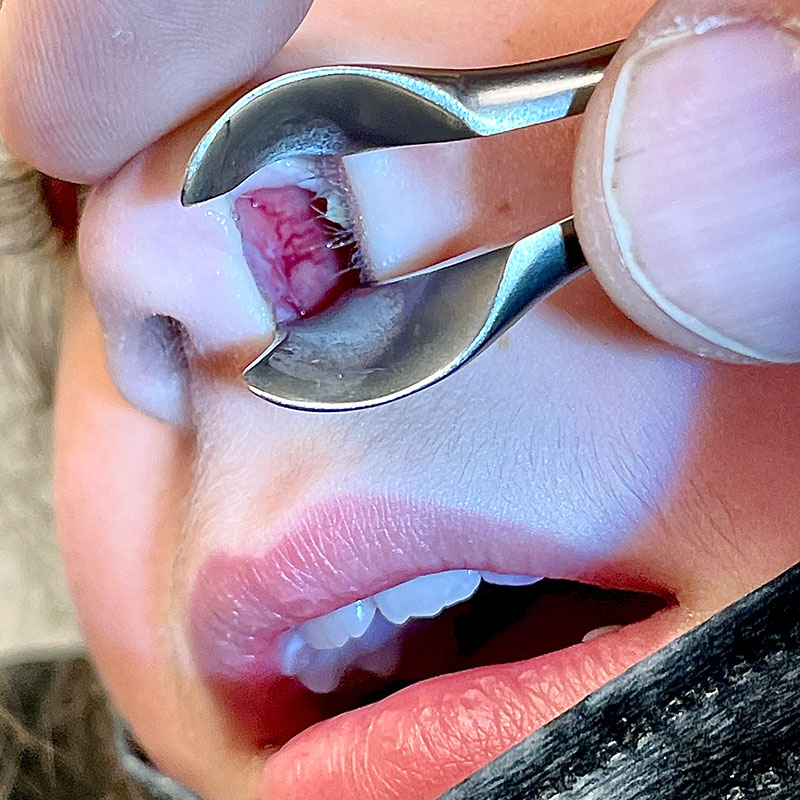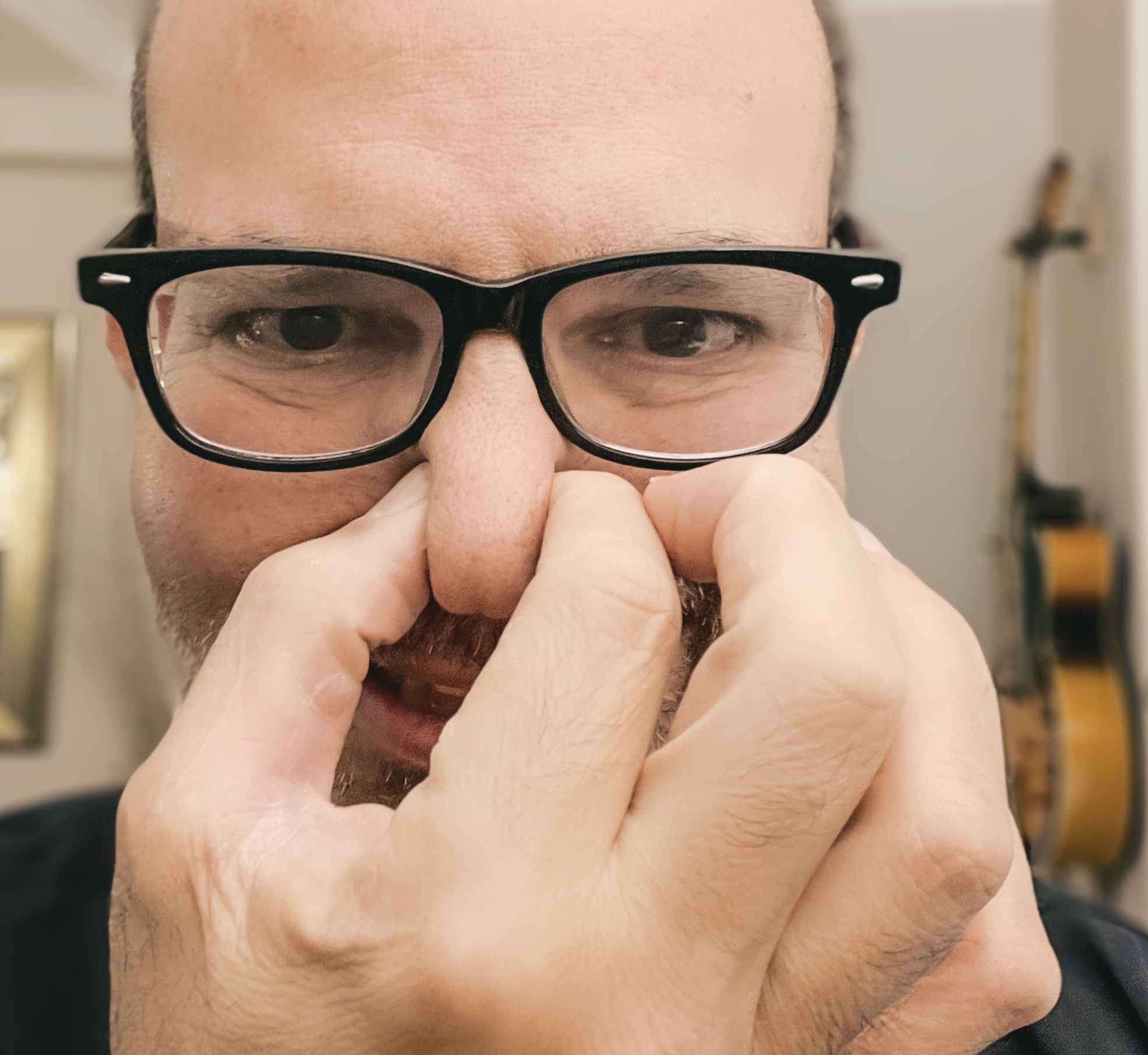Nosebleeds in Scuba Diving

Reaching bottom depth over a spectacular Anguilla reef, I knew that I was in trouble. Not serious dive trouble, I had plenty of gas and my gear was all working normally. But I knew that I was looking at a very uncomfortable ascent. And as they say, descents are optional, ascents are mandatory.
I had started the dive with some mild nasal congestion that had given me a bit of trouble on the way down. It had taken longer than normal to equalize my sinuses – specifically my maxillary sinuses, the big air filled spaces in my cheeks just below my eyes. When I ascended a bit, it was obvious that the compressed gas at ambient pressure – about 4 atmospheres at 100 feet – wasn’t going to come out of those sinuses easily, as it normally does.
Every well trained diver understands why we need to equalize the pressure in the body’s air filled spaces to ambient pressure as we descend. For many of us, this isn’t much trouble. The spaces that we are usually aware of are the middle ear clefts (behind the eardrum) – most divers need to actively push air into this space with a Valsalva or other maneuver. The ears are connected to the airway by a long pathway (the Eustachian tube, or ET) that is normally closed by the springy cartilage in the wall, and which opens with muscular activity. The paranasal sinuses are also air filled spaces that connect with the airway, but the connecting passageways are short and they don't dynamically open and close, like the ET. So most of the time, there is no problem with equalizing the sinuses. However, things like chronic sinus inflammation, acute infections, allergies or anatomic variants can make this more difficult.
A ”block” refers to a problem with this equalization process on the way down, making it difficult to get gas into one of these spaces. And we all know what to do with an ear block, right? Slow your descent and then stop if you can’t equalize. Then ascend a bit, if that doesn’t work. NEVER push through it. True anatomical or physiological problems with the ET preventing equalization are very rare. It’s almost always a technique issue.
A "reverse block" is much less common. This refers to the situation where there is a problem getting gas OUT of the ears or sinuses on ascent. Just like it’s easier to get toothpaste out of a tube than back into it, there generally isn’t any problem equalizing on the way up. The expanding gas in the ear or the sinuses usually just pushes its way out. Usually, but not always. And sooner or later, you need to either evolve gils or get back to the surface, equalized or not.
In this worst case scenario (surfacing without equalizing) the ear and the sinuses are very different. In the ear, the eardrum acts like the burst disk in a scuba tank. It’s just a thin membrane, and if the gradient (the difference between middle ear and ambient pressure) gets big enough, the eardrum will burst. The sinuses on the other hand are bony cavities. In very rare cases the wall of the sinuses can burst into the area around the eyes or even the brain causing serious injury, but that's beyond the scope of this article. More commonly they just act like little scuba tanks in your face. They hold gas under pressure against a significant gradient, until they eventually decompress through their natural orifices into the nasal airway. And that gradient hurts.
So that’s what happened to me - a reverse sinus block. I tried my best to equalize on ascent, doing a reverse Valsalva maneuver where I tried to suck air out of the sinuses into my nose. But it didn’t work. I climbed back on the dive boat in agony, still wearing my mask.
I couldn’t pay attention to anything the crew was saying, I just kept trying to equalize. It was miserable. And then it happened. A sudden explosion of blood and snot into my mask. That was the single best sensation that I have ever had diving – it’s hard to describe what an incredible relief I felt at that time, when I finally was able to equalize.
So why all the blood? Well, the lining of the nose and sinuses is a tissue called mucosa, and it has an excellent blood supply. It doesn’t take much trauma to make that tissue tear and bleed – ask anyone who has had a nasal fracture. The trauma in scuba is barotrauma from that pressure gradient. And this is the most common cause of nosebleeds (also known as epistaxis) in diving. Even if there isn’t a severe reverse block, divers often will have slow or intermittent equalization of the sinuses on ascent and descent, resulting in some bleeding from the sinuses into the nasal airway.
Although what I described above is the most common reason for epistaxis in scuba, the mechanism for nosebleeds NOT associated with diving is completely different. Let me take a slight detour here and explain that.
The nasal septum is the cartilage wall in the center of the nose that divides the airway in half, and it is also lined with mucosa. There is an area in the very front of the septum, just inside the nostrils, called “Little’s area”, and this is where the vast majority of nosebleeds come from. There are two reasons for this.
I had started the dive with some mild nasal congestion that had given me a bit of trouble on the way down. It had taken longer than normal to equalize my sinuses – specifically my maxillary sinuses, the big air filled spaces in my cheeks just below my eyes. When I ascended a bit, it was obvious that the compressed gas at ambient pressure – about 4 atmospheres at 100 feet – wasn’t going to come out of those sinuses easily, as it normally does.
Every well trained diver understands why we need to equalize the pressure in the body’s air filled spaces to ambient pressure as we descend. For many of us, this isn’t much trouble. The spaces that we are usually aware of are the middle ear clefts (behind the eardrum) – most divers need to actively push air into this space with a Valsalva or other maneuver. The ears are connected to the airway by a long pathway (the Eustachian tube, or ET) that is normally closed by the springy cartilage in the wall, and which opens with muscular activity. The paranasal sinuses are also air filled spaces that connect with the airway, but the connecting passageways are short and they don't dynamically open and close, like the ET. So most of the time, there is no problem with equalizing the sinuses. However, things like chronic sinus inflammation, acute infections, allergies or anatomic variants can make this more difficult.
A ”block” refers to a problem with this equalization process on the way down, making it difficult to get gas into one of these spaces. And we all know what to do with an ear block, right? Slow your descent and then stop if you can’t equalize. Then ascend a bit, if that doesn’t work. NEVER push through it. True anatomical or physiological problems with the ET preventing equalization are very rare. It’s almost always a technique issue.
A "reverse block" is much less common. This refers to the situation where there is a problem getting gas OUT of the ears or sinuses on ascent. Just like it’s easier to get toothpaste out of a tube than back into it, there generally isn’t any problem equalizing on the way up. The expanding gas in the ear or the sinuses usually just pushes its way out. Usually, but not always. And sooner or later, you need to either evolve gils or get back to the surface, equalized or not.
In this worst case scenario (surfacing without equalizing) the ear and the sinuses are very different. In the ear, the eardrum acts like the burst disk in a scuba tank. It’s just a thin membrane, and if the gradient (the difference between middle ear and ambient pressure) gets big enough, the eardrum will burst. The sinuses on the other hand are bony cavities. In very rare cases the wall of the sinuses can burst into the area around the eyes or even the brain causing serious injury, but that's beyond the scope of this article. More commonly they just act like little scuba tanks in your face. They hold gas under pressure against a significant gradient, until they eventually decompress through their natural orifices into the nasal airway. And that gradient hurts.
So that’s what happened to me - a reverse sinus block. I tried my best to equalize on ascent, doing a reverse Valsalva maneuver where I tried to suck air out of the sinuses into my nose. But it didn’t work. I climbed back on the dive boat in agony, still wearing my mask.
I couldn’t pay attention to anything the crew was saying, I just kept trying to equalize. It was miserable. And then it happened. A sudden explosion of blood and snot into my mask. That was the single best sensation that I have ever had diving – it’s hard to describe what an incredible relief I felt at that time, when I finally was able to equalize.
So why all the blood? Well, the lining of the nose and sinuses is a tissue called mucosa, and it has an excellent blood supply. It doesn’t take much trauma to make that tissue tear and bleed – ask anyone who has had a nasal fracture. The trauma in scuba is barotrauma from that pressure gradient. And this is the most common cause of nosebleeds (also known as epistaxis) in diving. Even if there isn’t a severe reverse block, divers often will have slow or intermittent equalization of the sinuses on ascent and descent, resulting in some bleeding from the sinuses into the nasal airway.
Although what I described above is the most common reason for epistaxis in scuba, the mechanism for nosebleeds NOT associated with diving is completely different. Let me take a slight detour here and explain that.
The nasal septum is the cartilage wall in the center of the nose that divides the airway in half, and it is also lined with mucosa. There is an area in the very front of the septum, just inside the nostrils, called “Little’s area”, and this is where the vast majority of nosebleeds come from. There are two reasons for this.

"Little's area" is the part of the nasal septum (the wall in the middle of the nose) that is just inside the nostril.
"Kiesselbach's plexus" is the group of blood vessels on the septum that dry out and bleed.
"Kiesselbach's plexus" is the group of blood vessels on the septum that dry out and bleed.
First, the area has a very good blood supply, sometimes with large blood vessels on the surface (“Kiesselbach’s plexus”). Second, this area is the one place in the body where mucosa with a rich blood supply frequently dries out. It is constantly “in the wind” as normal breathing moves a dozen lungfuls of gas over it every minute. And unlike the rest of the airway, which is internally protected and remains humid, Little’s area is constantly bathed in dry external air.
There isn’t even a protective mechanism to keep it moist. The mouth is also lined with mucosa, but very few people get "mouthbleeds" because the mouth is usually wet with saliva. That’s why your number one ally in the fight against nosebleeds is keeping the nose moist. Room humidifiers are good, especially in dry winter air, but they must be kept clean. Saline sprays (with or without the natural sugar xylitol) and aqueous ointments (like Bactroban) also help.
Sometimes recurrent or severe nosebleeds require medical attention. In rare cases they are due to medical problems with clotting, high blood pressure, or even growths in the nose or sinus. And if none of those are an issue, cautery can help. In the office, this usually involves touching Kiesselbach’s plexus with an irritating chemical like silver nitrate, which causes the vessels to clot off and scar over. While no doctor can completely prevent nosebleeds, between lubrication, humidification and cautery, they can be made a lot less common.

To stop most nosebleeds, just pinch the nostrils together, NOT the bridge of the nose. This compresses any vessels in Little's area - the most common site of bleeding.
But the first thing to remember if you ever get a nosebleed is this. Because of where Little’s area is, you stop epistaxis by PINCHING THE NOSTRILS TOGETHER. This will stop 95% of nosebleeds if you hold pressure for a while. For some reason, people have the idea that you should pinch the bony bridge of the nose, between the eyes. I don’t know where that came from, but it doesn’t help.
So getting back to the original topic of this article, what should you do to prevent and treat epistaxis associated with diving? Well, if you are very congested, you shouldn’t dive. And if you decide to try anyway, don’t push through any equalization problems. Go slowly, and make sure that you can descend without a lot of trouble. And as always, any diver can call any dive at any time for any reason. Don’t hesitate to thumb a dive if you are in this situation, and communicate any anticipated problems with your buddy ahead of time.
Some divers get nosebleeds not associated with sinus barotrauma, just from irritation of the area. Frequent Valsalva maneuvers for ear equalization can traumatize the nasal septum by pinching the nose tightly, so lubricating sprays or ointment can help here as well. A decongestant spray like Afrin will cause the nasal blood vessels constrict, which can stop or prevent minor bleeding. You also should know that nasal steroids (like Flonase) which are commonly used by divers for congestion or to help with ear equalization can cause epistaxis. Also, they don’t help with ear equalization.
Packing the nose is rarely a good idea. Unless you are trained to do this and have the equipment to retrieve any packing pieces that get stuck in the nose, this can cause trouble. Also, they can cause more bleeding when they are removed. If the nosebleed is from Little’s area, pinching the nose will usually work just as well as packing. If the bleeding is from sinus barotrauma, it’s unlikely that packing will actually stop it (although you may see it less!). In some cases of severe bleeding, packs are used, but they are generally not the best option for typical nosebleeds.
So if you have a nosebleed during or after diving, don’t panic. Pinch your nostrils together, use some Afrin (three days ONLY), and keep your nose moist.
Oh, and if it’s a shark dive, maybe keep your mask on until you are back on the boat!